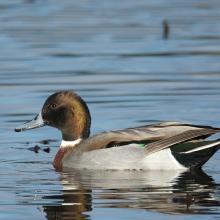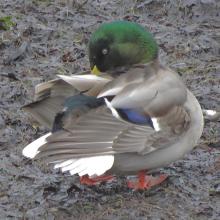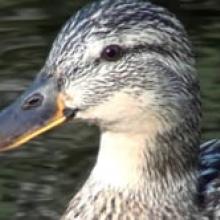

Join BirdNote tomorrow, November 30th!
Illustrator David Sibley and actor H. Jon Benjamin will face off in the bird illustration battle of the century during BirdNote's Year-end Celebration and Auction!
Mallards are found virtually everywhere there is open water, from city parks and subalpine lakes to sheltered bays and estuaries along the coasts. In their breeding plumage, male Mallards are avian dandies. The male's primary goal is to attract a mate and defend the breeding territory. The female's is to blend in with the natural surroundings, while incubating the eggs and caring for the young. And the female Mallard is the only one that can quack!
BirdNote®
Everybody Knows a Mallard
Written by Frances Wood
This is BirdNote!
[Mallard female, loud quacking]
You can probably guess the bird making that familiar quacking. It’s our most recognizable duck, the Mallard. But did you know that only female Mallards quack?
[Mallard female, loud quacking]
In their breeding plumage, male Mallards are avian dandies. They sport a metallic green head, lemon-yellow bill, narrow white collar, and chestnut breast. Their back is pale grey, and their wings flash brilliant blue-violet feathers mid-way down the wing. If that isn’t enough to lure female Mallards, a charming curl adorns the male’s central tail-feathers, unlike any other bird in North America.
Female Mallards, on the other hand, are plumed in subdued mottled browns. The male’s primary goal is to attract a mate and defend the breeding territory. The female’s is to blend in with the natural surroundings, while incubating the eggs and caring for the young. Fairly soon after the breeding season, say, June or July, watch for the males to become quite drab. They’re molting; their old feathers are coming out, while new ones grow in.
Yet, despite any outward changes in plumage, the female’s ability to quack loudly never diminishes during the year.
[Mallard female, loud quacking]
For BirdNote, I'm Mary McCann.
###
Bird sounds provided by The Macaulay Library at the Cornell Lab of Ornithology, Ithaca, New York. Recorded by A.A. Allen.
Ambient sound recorded by C. Peterson at Ellis Pond.
BirdNote's theme music was composed and played by Nancy Rumbel and produced by John Kessler.
Producer: John Kessler
Executive Producer: Chris Peterson
© 2015 Tune In to Nature.org March 2017 / 2021/2024 Narrator: Mary McCann
ID # 032305MALL MALL-01b-2009-03-08







